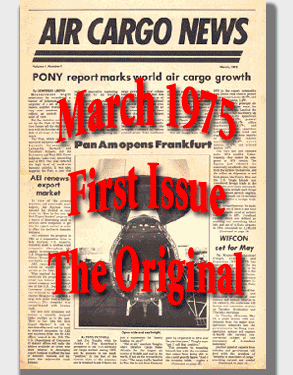
 o
doubt about it, when Issa Baluch stepped down and quit the Board of
TIACA in protest late in 2013, the impact was felt throughout the air
cargo industry and continues to reverberate into early 2014. o
doubt about it, when Issa Baluch stepped down and quit the Board of
TIACA in protest late in 2013, the impact was felt throughout the air
cargo industry and continues to reverberate into early 2014.
Issa almost single handedly invented the Sea Air business in Dubai as
CEO of Swift Air.
Issa raising a ruckus in protest to TIACA cannot and should not be taken
lightly.
This is not about choosing sides either.
After making his fortune and departing Swift, Issa Baluch has continued
in air cargo teaching logistics as a visiting Professor at Harvard University
in Boston, and was also keeping up as a long time member of the TIACA
Board and many other volunteer posts.
In other words, all of this easily profiles
Mr. Baluch as the ultimate inside guy.
Last week FT included the remarks
of Oliver Evans, TIACA Chairman, who succinctly laid out his plan for
the organization for 2014 and beyond.
Here we revisit with Issa, wondering what
in the world comes next.

“In 2011, I was accepted by Harvard
University to become a Fellow in their newly set up program called Advanced
Leadership Initiative (ALI).
“The following year, I became a
senior Fellow and Associate of Science, Technology, and Globalization
at Harvard Kennedy School. At present, I am considered as a visiting
Senior Fellow.
“Harvard encourages all ALI Fellows
to initiate a social impact project and so, as one of the investors
in a 10,000 hectare farm (Africa Atlantic Farms) on the Afram plains
alongside Lave Volta (the world’s largest water reservoir) in
Ghana, West Africa, we studied the prospects of planting a Knowledge
Canter as a depository of skills and experiences gained from the commercial
farm.”

“This project,” Issa explains,
“now in its 3rd year, picked up momentum and we formally launched
the Africa Agribusiness Knowledge Centres (AAKC), where I was appointed
Chairman.
“The effort is one of a kind and
is supported by Harvard Kennedy School's Science, Technology, and Globalization
Project department, MIT, Masdar Institute of Abu Dhabi, and most recently,
the DC-based Corporate Council on Africa (CCA).”

“A master plan developed via a charrette
has just been completed by MIT in October of last year.
“The complete project design includes
an airport, logistics and cool chain centers, and the AAKC facility,
among others. A 27-course curriculum is also being drawn up to offer
youth, farm workers, and all participants up-to-the-minute technology
to improve farm production.
“Phase One of AAKC is set to launch
on the first quarter of 2014.
“My own contribution will be logistics
and work experience in Africa, particularly in distribution, as the
entire project is driven from a demand angle and food security is a
big ticket item locally, regionally, and internationally.
“The stakeholders of this project
are committed to a vision of scaling this model across the continent
of Africa.
"In 2014 AAKC will have a presence
in 3 countries and in 5 years we anticipate managing a total of 100,000
hectares.

It is now about 3 months since Issa resigned
from the TIACA board saying that in his view, these days the objectives
of a few outweigh the needs of the many in that industry organization.
As for regrets…
“None whatsoever,” Mr. Baluch
says emphatically.
“I only hope the underlying reasons
of my departure will help this organization move forward.
“One of the commentators stated
that I should have not come out in public with dirty linen about TIACA.
“Sorry, I spent the last 5 years
working from within and it appeared I was making progress.
“In actual fact, the contributions
I made seemed fully acceptable but when it came to implementation, it
was entirely something else.
“I gave this process the benefit
of the doubt for many years until it reached a point when I could not
take it anymore.
“A number of current board members
are my personal friends and fully agree with me.
“I respect their positions that
they decided to keep quiet and not come out in public.
“Everyone has their own reasons
and while I do not like what I see, I still respect their position.
“One thing I am very certain about
is that my departure will continue to have an impact since the last
chapter has yet to be written.
“TIACA belongs to its members.
“Elected officers are there to deliver
value to the membership and if they fail then there will be repercussions.
“Elected officers should bear in
mind what has been handed to them and it is one simple item called ‘legacy.’
“I firmly believe this leadership
has got these things mixed up and, if they are honest, they will ask
themselves if all the changes they have authored are really worth it.”
As for the admission of WCA into the TIACA
board, Issa has some thoughts on that as well.
“I suppose you mean the induction
of David Yokeum as TIACA's board member?
“If anything great has happened
in 2013, this is great news for TIACA.
“I know David and he is an excellent
leader and a true entrepreneur who has done wonders for SME's.
“Will the powers that be allow David
Yokeum to perform?
“Will he have enough oxygen to do
what needs to be done?
“These are key questions. The reason
I raise them is because SME's have had no room in TIACA.
“And remember, for a long time now,
TIACA has been dubbed a club for Airlines and Airports.
“I was the only freight forwarder
on the board for a long time.
“And there are split objectives
with the various segments.
“Multinationals would like to focus
on lobbying and policies in Washington, D.C., and Brussels.
“SME's want to focus on business
networking and alliances.
“How do you marry these objectives
to give results to each?
“For a long time SME's shied away
from TIACA because they saw no value to them. This will remain TIACA's
huge problem, particularly now when the leadership is showing preference
to pursue a membership drive and less emphasis on the Air Cargo Forum.
“What value does David Yokeum bring
to the table?
“The stuff I have outlined earlier,
and not knowing the actual deal, I hope he will entice at least 10 percent
of WCA's membership (equivalent to 500 members) to participate at the
ACF 2014 in Korea.
“This will be a game changer for
TIACA.”
As for what Issa thinks about the new
board and the direction of TIACA: “The jury is out on them.
“Two items brew in my mind right
now: How many members will renew their membership in view of the commotion
that has been created?
“The second refers to the shift
in strategy and importance of the ACF.
“I hope that this new TIACA Board
is committed to doing the right things and to working hard to achieve
the required results to give TIACA enough money to survive. More important
than the board is the experience, maturity, and morale of the TIACA
staff.
“Are they getting the leadership
support to do what it takes to deliver results?
“Time will tell.
Mr. Baluch even has further advice for
TIACA members.
“Each member should carefully weigh
the usual business considerations when joining any association, such
as if it is producing the desired value to its business; or if the goals
set meet the company's interests.
“Also, members should be careful
of associations that undergo drastic changes, particularly if those
changes were driven for the benefit of only a few in its leadership.
“Ultimately, the decision lies with
the member; and I would hope that the enlightened decision is carefully
considered before signing on the dotted line of the 2014 membership
renewal cheque.”
Geoffrey
|







